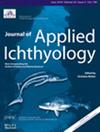Body Size Descriptions of a Trophy-Class Shovelnose Sturgeon (Scaphirhynchus platorynchus) Population in a Large Unexploited River System
Abstract
Sturgeon species (Acipenseridae) around the world have undergone substantial population declines over the past century due to a suite of anthropogenic actions and overharvest. Shovelnose sturgeon are the smallest and most abundant sturgeon species in North America and still support commercial and recreational fisheries despite notable declines in abundance and population structure throughout much of their range. The Rock River, located in Northwestern Illinois, USA, has recently attracted angler attention in response to numerous state record shovelnose sturgeon captured via recreational angling (unregulated recreational fishery), thus prompting the need to understand the size structure and demographics of this largely undescribed population to inform management actions. This study was the first to describe relative condition and size distributions of shovelnose sturgeon in the Rock River, Illinois. A total of 1324 unique shovelnose sturgeon were captured between Fall of 2022 and Winter 2024-2025, with 22% of captured fish meeting or exceeding trophy size class requirements (≥ 810 mm). Shovelnose sturgeon in the Rock River can reach larger body sizes (length and weight) than other regional systems. The Rock River supports the highest proportion of trophy class shovelnose sturgeon in the world. Although no commercial exploitation occurs, recreational angling is currently unregulated, and this population may be vulnerable to substantial shifts in population structure that may warrant management action. Future research seeks to gain a better understanding of population dynamics and develop robust long-term monitoring protocols to inform data-driven management.


 求助内容:
求助内容: 应助结果提醒方式:
应助结果提醒方式:


